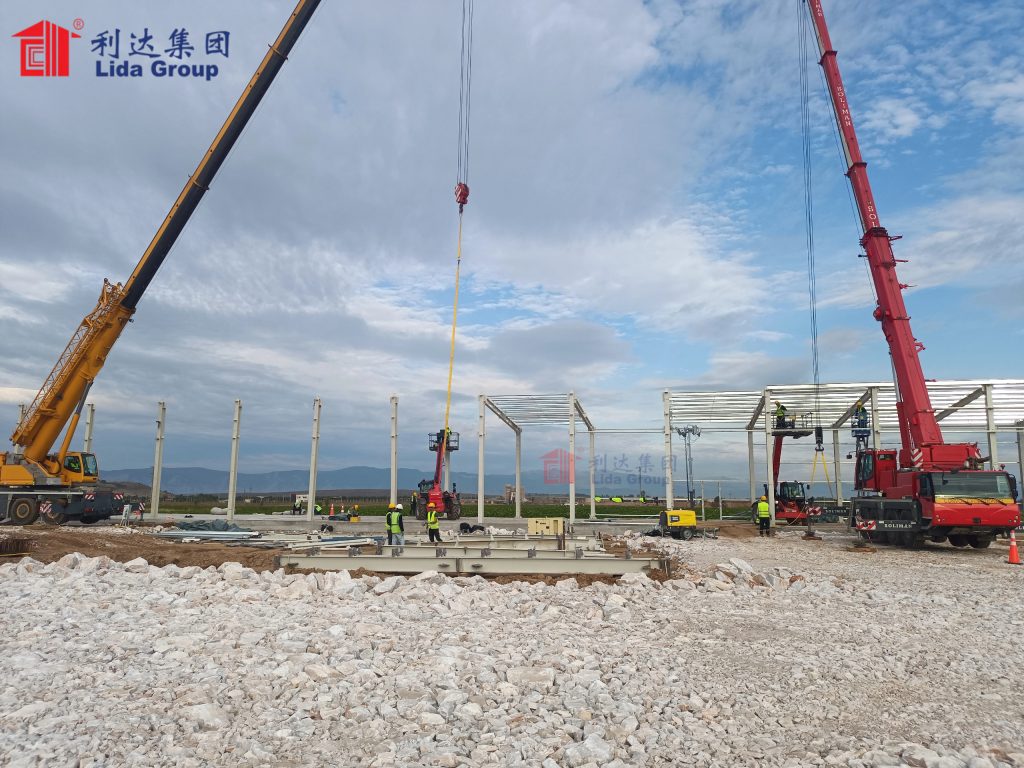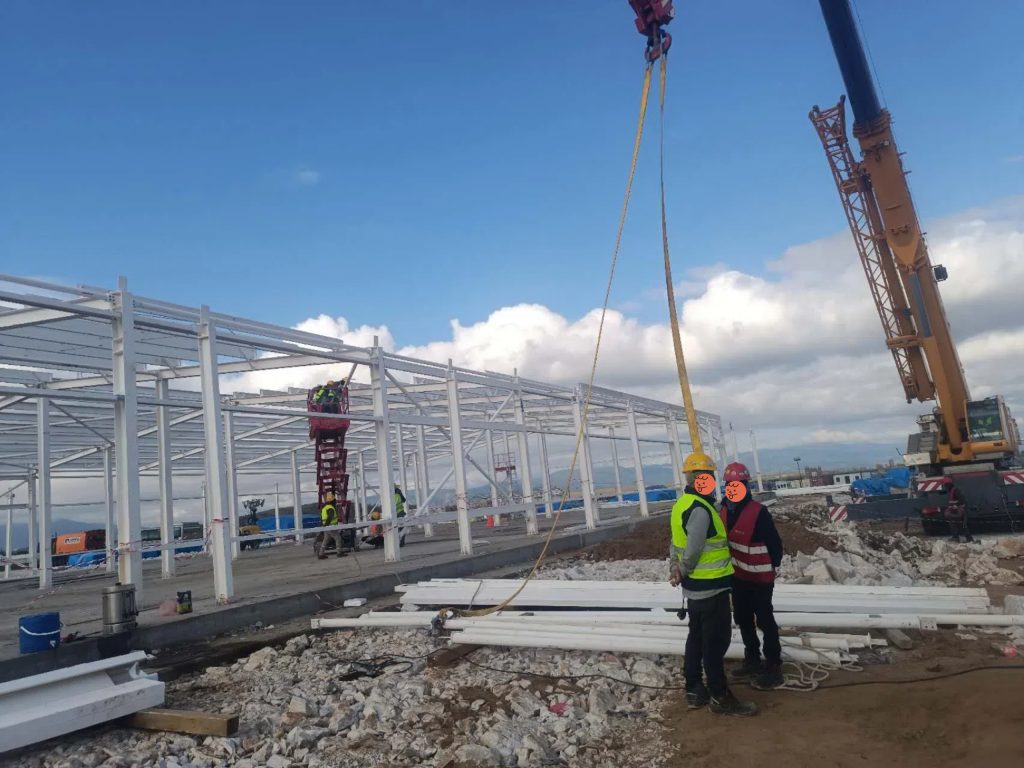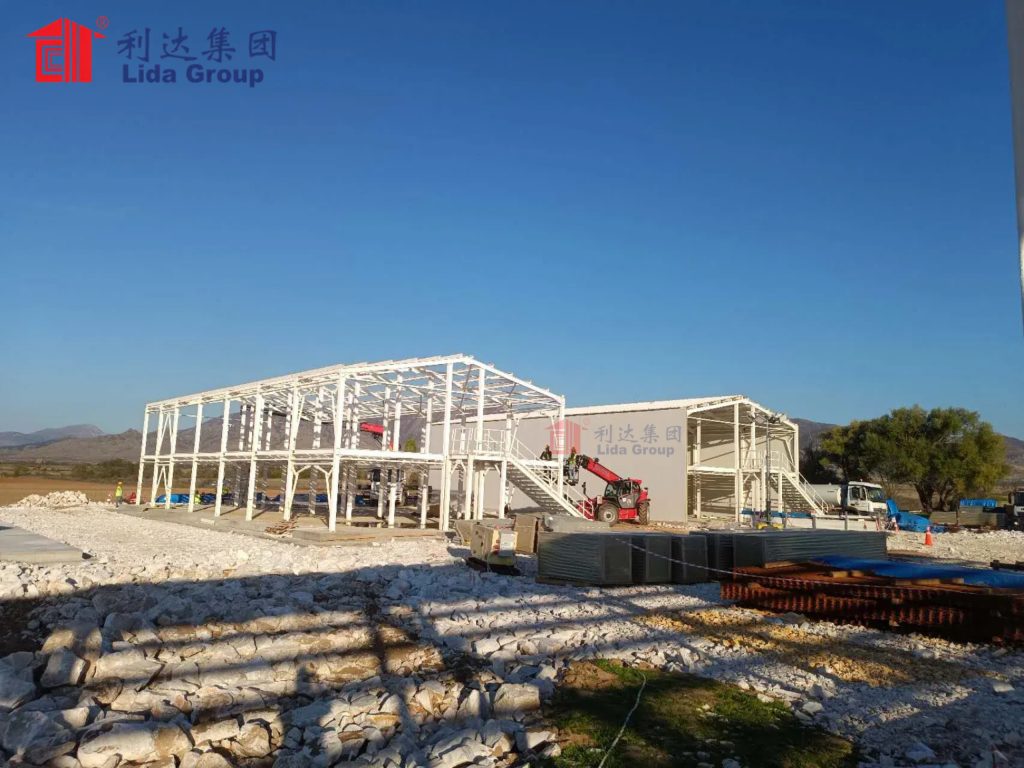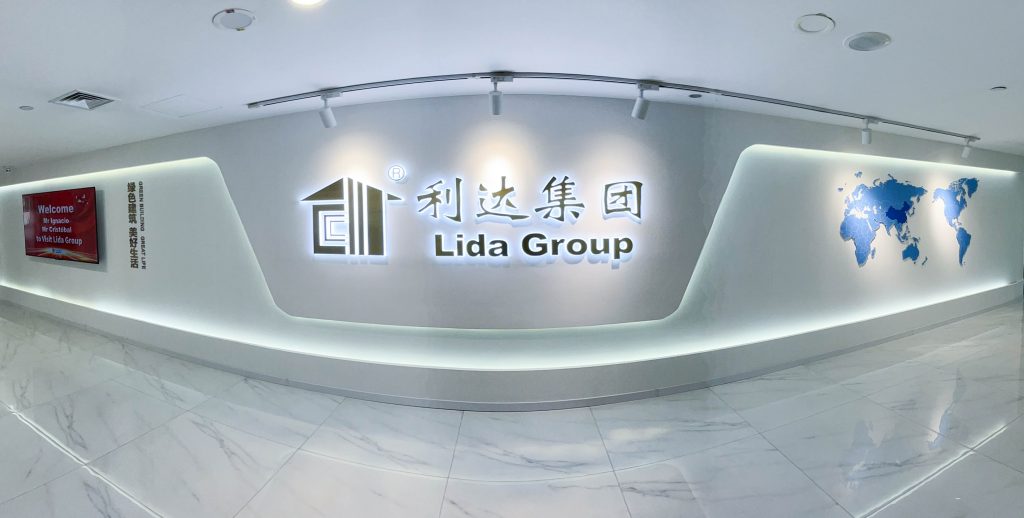Innovative Steel Structure Building Solutions by Lida Group
2025-Nov-11 17:59:17
By Admin
1. Introduction: The Evolution of Steel Structure Construction and Lida Group’s Pioneering Role
In an era defined by global supply chain acceleration, manufacturing innovation, and the urgent demand for sustainable development, the construction industry is undergoing a profound transformation. Conventional building methods, once the backbone of infrastructure development, now struggle to meet the contemporary requirements of speed, precision, safety, and environmental responsibility. Industrial warehouses need column-free spans exceeding 60 meters to accommodate automated storage and retrieval systems; advanced manufacturing plants require vibration-damped floors with micron-level stability; and offshore energy facilities must withstand extreme weather conditions ranging from Arctic cold to typhoon-force winds. Against this backdrop, steel structure buildings have emerged as a transformative solution, and Lida Group has positioned itself at the forefront of this revolution, redefining industry standards through integrated innovation across design, manufacturing, and construction.
Founded with a commitment to engineering excellence and customer-centricity, Lida Group has evolved from a regional construction service provider to a global leader in steel structure and modular building solutions. With a comprehensive portfolio spanning industrial warehouses, manufacturing plants, offshore energy infrastructure, public venues,and integrated camps, the group has established a reputation for delivering projects that balance performance, efficiency, and sustainability. Operating across continents—from the South China Sea to the North Sea, and from the deserts of Saudi Arabia to the industrial hubs of Europe—Lida Group’s solutions address the unique challenges of diverse geographies and industries. This article explores the technological innovations, process standards, application scenarios, and landmark projects that define Lida Group’s innovative steel structure building solutions, highlighting how the company is shaping the future of modern construction.

2. Technological Innovation: The Core Drivers of Lida Group’s Solutions
At the heart of Lida Group’s success lies a relentless focus on technological advancement, merging computational engineering, advanced materials science, and digitalization to create steel structure systems that outperform traditional alternatives. These innovations not only enhance structural performance but also optimize efficiency, reduce environmental impact, and enable customization for diverse project needs.
2.1 Advanced Materials Science: Strength, Durability, and Sustainability
Lida Group’s commitment to material innovation is evident in its selection of high-performance steels and composite materials, tailored to meet the demands of specific applications. A cornerstone of this approach is the use of high-strength S550MC steel, which delivers 45% greater yield strength than conventional structural steels. This material advantage enables the design of column-free spaces exceeding 60 meters, liberating industrial warehouses and logistics hubs from obstructive supports that constrain automated systems and operational flexibility . For offshore and coastal projects, where corrosion is a critical challenge, the group employs ASTM A588 steel frames—a weathering steel that forms a protective oxide layer, eliminating the need for frequent repainting and extending service life in salt-rich environments .
Beyond structural steel, Lida Group integrates innovative composite materials to enhance sustainability and performance. In cold storage facilities, aerogel insulation composite walls achieve R-value 40 within slim profiles, reducing HVAC loads by 40% compared to conventional structures and ensuring temperature consistency of ±0.3°C—essential for pharmaceutical and food storage applications . For offshore and modular projects, the group uses 92% recycled aluminum cladding sourced from decommissioned oil rigs and seaweed-based bio-insulation with an R-value of 5.2 per inch, aligning with circular economy principles and reducing embodied carbon . Protective coatings further elevate durability: automated systems apply uniform 300µm zinc-aluminum coatings that resist chemical exposure and UV degradation, while nano-ceramic coatings provide ten-year corrosion protection in coastal regions .
2.2 Computational Engineering and Digital Twin Technology
Digitalization has revolutionized Lida Group’s design and engineering processes, enabling precision and predictability that were previously unattainable. The group leverages computational engineering to optimize structural geometries, reducing steel tonnage by 25-28% while enhancing load capacity—a paradoxical achievement that balances material efficiency with structural performance . Computer-optimized truss systems, for example, are engineered to distribute stress evenly across the structure, minimizing waste and maximizing strength.
A transformative technology in Lida Group’s toolkit is digital twin technology, which creates virtual replicas of steel structure buildings before fabrication begins. These digital models simulate decades of environmental stress, modeling how seismic events affect connection integrity, how desert UV radiation degrades coatings, and how typhoon-force winds impact structural stability . For offshore projects, digital twins integrate computational fluid dynamics to optimize airflow around equipment and vibration analysis to predict how structural harmonics might disrupt sensitive instruments. This virtual prototyping eliminates costly field modifications: by identifying potential issues in the digital realm, Lida Group ensures that facilities perform as engineered from day one. In automated warehouse projects, for instance, digital twins verify that floor flatness meets the 3mm/10m tolerance required for robotic navigation, guiding laser-guided pouring processes to achieve precision impossible with conventional methods .
2.3 Modular and Prefabrication Technologies
Lida Group has embraced modularization and prefabrication as key strategies to accelerate project delivery and ensure quality consistency. In controlled factory environments, robotic welding cells assemble primary steel frames with 0.2mm tolerances—far exceeding the precision of manual welding . CNC machines notch connection points with laser-guided accuracy, creating components with 99.97% interchangeability across global projects, which streamlines on-site assembly and reduces reliance on skilled labor .
This prefabrication approach is particularly evident in the group’s modular container-based solutions. For offshore oil and gas projects, Lida Group manufactures stackable container units with interlocking foundation anchors, enabling rapid deployment on rigs and platforms. In the South China Sea, 8-story crew quarters built from these modules survived Super Typhoon Saola (2023) unscathed, while adjacent structures sustained $6 million in damage . Similarly, for the Saudi 内政部 project, 21 prefabricated double-story units were assembled into a 25,000㎡ facility in record time, with delivery speed exceeding industry averages by 30% . Prefabrication also reduces construction waste by 30% compared to traditional methods, aligning with Lida Group’s sustainability goals .

3. Full-Process Standardized Management: Ensuring Quality and Safety
Lida Group’s commitment to excellence extends beyond technology to the rigorous management of every construction phase. The group has developed a four-stage standardized control system—covering foundation engineering, component hoisting, welding and connection, and final acceptance—that ensures consistency, safety, and compliance with global standards. This system has made Lida Group a benchmark for quality in sectors ranging from Super high-rise buildings to industrial factories .
3.1 Foundation Engineering: The First Line of Precision
The stability of any steel structure depends on its foundation, and Lida Group treats this phase as critical to long-term performance. The group employs prefabricated drilled steel formwork for anchor bolt positioning, ensuring that bolt locations are calibrated to within ±2mm of design specifications. After installation, bolts are welded to the reinforcing steel mesh and protected with specialized caps to prevent damage during concrete pouring .
To further enhance precision, Lida Group establishes a joint inspection mechanism with civil engineering partners. During concrete pouring, technicians monitor bolt positions and elevation in real-time, making adjustments as needed. Post-pouring, the group conducts a comprehensive review with Supervision unit ,verifying that foundation bearing surface flatness meets a maximum deviation of 3mm and that bolt protrusion lengths align with design values (±5mm). In one industrial factory project, this process resulted in 100% qualification of 120 sets of anchor bolts, laying the groundwork for zero-deviation installation of upper steel structures .
3.2 Component Hoisting: Safe and Efficient Modular Installation
Hoisting is a high-risk phase of steel structure construction, and Lida Group mitigates risks through meticulous planning and differentiated processes for various components. Prior to hoisting, The group conducts a full-site assessment: re-measuring the elevation of the anchor bolt clearing obstacles from hoisting routes, and inspecting incoming components for transportation damage. Measurement tools—such as levels with ±0.1mm precision—are calibrated to ensure uniformity .
For steel column hoisting, Lida Group uses a single-machine rotation method, ensuring that the lifting point, column base center, and foundation center lie on a common arc. Before full lifting, a test lift 20cm above the ground verifies stability. When lowering the column to the installation surface (40-100mm above the foundation), technicians align it with reference lines and perform initial verticality correction (deviation ≤20mm) before detaching the hoist. Final correction uses two theodolites (positioned along longitudinal and transverse axes) to achieve a verticality deviation of ≤H/1000 (where H is column height) .
For steel beam hoisting, the group assembles beams on the ground and uses a two-point lifting method to prevent deformation. After lifting, workers use guide ropes to adjust position, securing beams with high-strength bolts temporarily. The first beam in each section is stabilized with two wind ropes, while subsequent beams are reinforced with roof purlins. In a commercial office project, this process resulted in 100% qualification of 300 steel beams, with installation completed five days ahead of schedule due to pre-hoisting preparation .
3.3 Welding and Connection: The “Backbone” of Structural Integrity
Welding and bolted connections are the critical junctions of steel structures, and Lida Group’s precision in these areas ensures load transfer and long-term stability. For high-strength bolt connections, the group adheres strictly to national and industry standards, using large hexagonal bolts for beam-column joints. Installation is performed in dry conditions (avoiding rain) with a tightening sequence that progresses from the center of the joint plate to the edges (prioritizing main components and upper flanges). After final tightening, bolts are inspected with torque wrenches to ensure torque deviation ≤±10%, with 2-3 exposed threads visible .
A dedicated team structure—four installers, two initial tighteners, two final tighteners—ensures that bolts are fully tightened on the day of installation. Strict quality control prohibits flame cutting of bolt holes; oversize holes are repaired with reamers (maximum diameter 1.2 times the bolt diameter). All bolts undergo witness sampling and testing by Supervision unit before use. In a heavy machinery factory project, this rigorous process resulted in 100% first-time acceptance of high-strength bolt connections .
For welding, Lida Group employs a differentiated approach based on steel grade: Q235 steel uses E4303 electrodes, while Q355 steel uses E506 electrodes. Positioning welds use φ3.2 electrodes, with filling and capping welds using φ4.0 electrodes. To minimize deformation and residual stress, the group uses symmetric welding (with even numbers of welders working simultaneously) and a three-step process: root welding, filling welding, and capping welding .
Quality control extends to environmental management: temporary wind and rain shelters are erected for outdoor welding, and electrode drying ovens (350-400°C) and insulation barrels ensure electrode performance. All welders hold valid certifications (100% certification rate). Post-welding inspection includes ultrasonic testing for Grade II butt welds (100% pass rate) and visual inspection for Grade III fillet welds (no cracks, pores, or slag inclusions). In a Super high-rise buildings project, 20% of beam-column joint welds underwent ultrasonic testing 24 hours after welding, achieving Grade III compliance—exceeding design requirements .
3.4 Final Acceptance and After-Sales Support: Closing the Quality Loop
Lida Group’s quality assurance system culminates in a three-level acceptance mechanism: team self-inspection, project department review, and joint acceptance by general contractor, supervisor and client. During self-inspection, teams document every process (e.g., bolt torque, weld appearance). The project department verifies construction records (e.g., concealed engineering reports, flaw detection records) and conducts on-site sampling of component installation precision. The final joint acceptance involves local quality inspection stations, design units, and clients, verifying structural performance (e.g., seismic capacity), appearance quality, and document completeness .
Beyond completion, Lida Group offers comprehensive after-sales support to extend asset life: a 5-year warranty for foundation engineering, annual free on-site inspections (e.g., bolt tightening, weld anti-corrosion), and full operational guidance. This commitment ensures that structures maintain performance over decades, enhancing client value .

4. Multi-Scenario Solutions: Adapting to Diverse Industry Needs
Lida Group’s innovative capabilities are reflected in its ability to tailor solutions to the unique demands of diverse sectors. From industrial logistics to offshore energy, public venues to extreme climate environments, the group’s steel structure systems deliver performance, efficiency, and sustainability across applications.
4.1 Industrial and Logistics Warehouses: Speed and Operational Excellence
The exponential growth of e-commerce and manufacturing has intensified demand for warehouses and plants that support automation, flexibility, and efficiency. Lida Group’s solutions address these needs through large-span designs, precision engineering, and rapid deployment. For a global logistics provider, the group completed a 500,000 sq ft warehouse in 60% less time than conventional methods, with a column-free span of 60 meters to accommodate automated storage and retrieval systems .
Key features of these solutions include: laser-guided poured floors (3mm/10m flatness for robotic navigation), composite insulation walls (±0.5°C temperature stability for cold storage), and seismic-resistant designs (critical for regions with active geology). The use of high-strength S550MC steel and computer-optimized trusses reduces steel consumption by 25% while supporting 500kg/m² live loads for multi-level mezzanines . These innovations transform warehouses from passive storage spaces into active assets that enhance supply chain efficiency.
4.2 Offshore Energy Infrastructure: Resilience and Sustainability
Offshore oil and gas exploration demands structures that withstand extreme conditions—typhoons, Arctic cold, explosions—and meet stringent environmental standards. Lida Group’s modular steel container solutions have redefined this sector, combining resilience with sustainability.
In the South China Sea Typhoon-Proof Drilling Crew Quarters project (client: CNOOC), the group delivered 8-story stackable units with ASTM A588 steel frames. Aerodynamic sloped roofs reduced wind load by 40%, and interlocking foundation anchors secured units during Category 5 typhoons. Watertight bulkheads (15m wave submersion rating) and helicopter evacuation pads enhanced safety. The units survived Super Typhoon Saola (2023) without damage, reducing crew rotation costs by 33% .
For Equinor’s North Sea Zero-Emission Offshore Offices, Lida Group developed hybrid containers with Solar Skin™ roofs (180W/m² thin-film PV) and 200kW hydrogen fuel cells (replacing diesel generators). An AI energy manager balanced consumption across 30+ units, while recycled aluminum cladding and seaweed insulation reduced embodied carbon. The project achieved net-zero energy status in 2024, saving 640 tons of CO₂e annually—equivalent to 1,500 Oslo-London flights—and became the first offshore container building certified under the EU Taxonomy for Sustainable Activities .
In the Gulf of Mexico Blast-Resistant Processing Modules (client: Shell USA), the group used 10mm armor steel walls (withstanding 12 psi overpressure, compliant with API RP 2FB) and blast relief vents to channel shockwaves. EMI-shielded control rooms protected electronics, and 78 prefabricated units were installed in 6 weeks during production shutdown. The modules survived 2024 hurricane season stress tests with zero downtime, reducing insurance premiums by 28% .
4.3 Public and Sports Venues: Aesthetics and Performance
Public 场馆 and sports facilities demand a balance of structural integrity, architectural flexibility, and crowd safety. Lida Group’s steel space frame systems have proven ideal for such projects, as demonstrated in the National Football and Basketball Academy Project in Qingdao, China. The group was responsible for installing 16,000㎡ of steel grid roofs for the academy’s training halls, using a combination of high-altitude bulk installation and integral hoisting. The most challenging section—Area A of Hall 1—featured a 48.6-meter span and 23.5-meter height, requiring precise coordination to ensure stability .
The project, a national-level facility combining education, training, and research, demanded compliance with strict seismic and load-bearing standards. Lida Group’s solution not only met these requirements but also enabled architectural flexibility, supporting the academy’s vision of creating an internationally renowned sports hub .
4.4 Extreme Climate and Integrated Camps: Adaptability and Sustainability
Lida Group’s solutions excel in harsh environments, from Arctic cold to desert heat, and in temporary or semi-permanent camp settings. For Eastern European extreme cold projects, the group used 150mm EPS sandwich panels and frost-resistant steel structures, enabling stable operation in -45°C to 50°C temperature ranges. Integration of solar roofs and rainwater collection systems ensured compliance with EU green building standards .
In Saudi Arabian desert projects, reflective coatings on steel modules reduced indoor temperatures by 8-10°C compared to traditional structures. RO reverse osmosis water purification systems provided stable water supply for 72 hours during outages, addressing the region’s water scarcity challenges . For Eastern European ecological camps, the group combined steel frames with container units, achieving wind load resistance of 1.5 kN/m². Bolted connections reduced on-site welding, cutting labor costs by 40% .

5. Sustainability: Aligning with Global “Dual Carbon” Goals
As the construction industry faces growing pressure to reduce carbon emissions, Lida Group has integrated sustainability into every aspect of its steel structure solutions. The group’s approach encompasses material efficiency, energy conservation, circular economy principles, and compliance with international green standards.
Material efficiency is a key pillar: computer-optimized designs reduce steel consumption by 25-28%, while prefabrication minimizes construction waste by 30% . The use of recycled materials—such as 92% recycled aluminum cladding and recycled steel—further reduces embodied carbon . Energy efficiency is achieved through high-performance insulation (aerogel, seaweed-based materials) and integrated renewable energy systems (solar roofs, hydrogen fuel cells), reducing operational emissions by up to 50% .
Lida Group’s commitment to sustainability is validated by international certifications: EU Taxonomy compliance for offshore projects, EU green building standards for extreme climate camps, and alignment with China’s “Dual Carbon” goals . The group’s net-zero energy offshore offices and low-carbon warehouses demonstrate that steel structure buildings can be both high-performance and environmentally responsible .

6. Conclusion: Leading the Future of Steel Structure Construction
Lida Group’s innovative steel structure building solutions represent a paradigm shift in modern construction, merging technological excellence, process standardization, and sustainability to address the diverse needs of global industries. From the high-strength S550MC steel frames that enable 60-meter column-free spans to the digital twins that predict decades of structural performance; from the four-stage quality control system that ensures zero-deviation installation to the modular containers that survive typhoons and achieve net-zero energy—every aspect of the group’s work reflects a commitment to redefining industry standards.
The group’s success is not only measured in technical achievements but also in real-world impact: reducing construction time by 60% for logistics hubs, saving 640 tons of CO₂e annually for offshore offices, and ensuring 100% safety for workers in typhoon-prone regions. By covering diverse scenarios—industrial warehouses, offshore energy, public venues ,extreme climates—Lida Group has proven that steel structure buildings are not just alternatives to traditional construction but superior solutions for the challenges of the 21st century.
As the global construction industry continues to evolve toward industrialization, digitization, and sustainability, Lida Group is well-positioned to remain a leader. Its focus on innovation, quality, and customer value ensures that it will continue to deliver solutions that drive efficiency, enhance safety, and reduce environmental impact. For industries seeking to build faster, smarter, and greener, Lida Group’s steel structure solutions are not just a choice—they are a blueprint for the future.

Related news
-
Lida Group Pioneers Advanced Steel Structure Building Techniques
2025-11-10 16:17:08
-
Discover the Benefits of Our Metal Frame Building Systems
2025-11-10 16:51:41
-
Discover the Benefits of Our Metal Frame Building Systems
2025-11-11 13:53:50
contact us
- Tel: +86-532-88966982
- Whatsapp: +86-13793209022
- E-mail: sales@lidajituan.com


